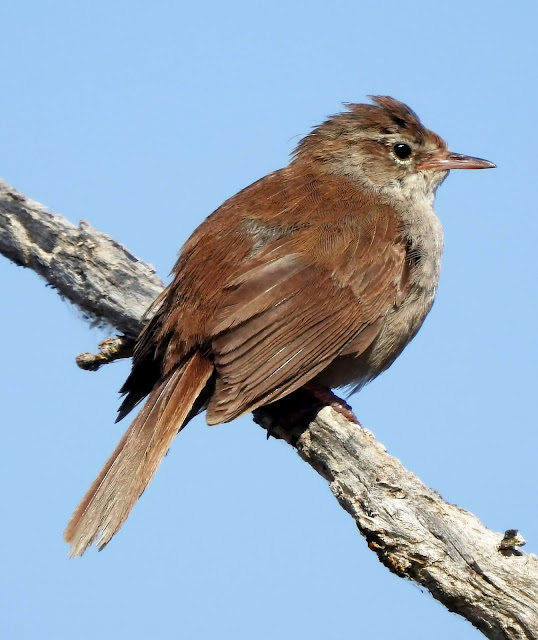The Cetti's Warbler (Cettia cetti) is a small, elusive bird with a rich chestnut or dark reddish-brown upperparts and pale grey underparts. It has a rounded head with a narrow pale grey stripe over its conspicuous black eyes, and short, rounded wings. The tail is notably longer and broader than many other warblers, and this species is unique among passerines for having ten tail feathers instead of the usual twelve.
Males and females of the Cetti's Warbler are similar in plumage, but males are significantly heavier and have longer wings. The male's wing length exceeds 60 mm, while the female's is shorter than 55 mm. Juveniles resemble adults but can be distinguished by their fresher plumage and two dark spots on the tongue.
Cetti's Warblers are typically found in damp environments such as ponds, lakes, marshes, and riversides, where they can be heard if not always seen.
This species breeds across southern and central Europe, northwest Africa, and eastward to Afghanistan and northwest Pakistan. Since 1990, their numbers have increased across Europe, with stable or growing populations in Italy and Turkey. The UK saw its first record in 1961, and it is now a rare vagrant in Ireland.
Cetti's Warblers are known for their skulking habits, making them a challenge to observe. They are territorial, especially during the breeding season, with males establishing their domains and attracting multiple females.
The song of the Cetti's Warbler is a loud, explosive burst of notes, which is distinctive and serves as a key identifier for the species.
The breeding season sees males defending their territories and attracting females with their song. Nests are built by the females in dense vegetation, with 4 to 5 chestnut-red eggs laid at daily intervals. The female incubates the eggs, which hatch after about 16 to 17 days. Fledglings are fed and cared for by the parents for an additional 15 days post-fledging.
Cetti's Warblers feed on arthropods, favoring small, soft-bodied insects and larvae which they can digest quickly.
The Cetti's Warbler is currently listed as Least Concern on the IUCN Red List, with a stable or increasing population in most of its range.












%2020.jpg)
%2020.jpg)